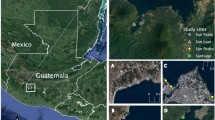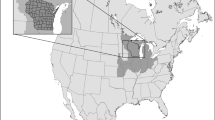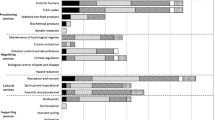Abstract
Given the recent strengthening of wetland restoration and protection policies in France, there is need to develop rapid assessment methods that provide a cost-effective way to assess losses and gains of wetland functions. Such methods have been developed in the US and we tested six of them on a selection of contrasting wetlands in the Isère watershed. We found that while the methods could discriminate sites, they did not always give consistent rankings, thereby revealing the different assumptions they explicitly or implicitly incorporate. The US assessment methods commonly use notions of “old-growth” or “pristine” to define the benchmark conditions against which to assess wetlands. Any reference-based assessment developed in the US would need adaptation to work in the French context. This could be quite straightforward for the evaluation of hydrologic variables as scoring appears to be consistent with the best professional judgment of hydrologic condition made by a panel of French local experts. Approaches to rating vegetation condition and landscape context, however, would require substantial reworking to reflect a novel view of reference standard. Reference standard in the European context must include acknowledgement that many of the best condition and biologically important wetland types in France are the product of intensive, centuries-long management (mowing, grazing, etc.). They must also explicitly incorporate the recent trend in ecological assessment to focus particularly on the wetland’s role in landscape-level connectivity. These context-specific, socio-cultural dimensions must be acknowledged and adjusted for when adapting or developing wetland assessment methods in new cultural contexts.







Similar content being viewed by others
References
Arnould P, Glon E (2006) Wilderness, usages et perceptions de la nature en Amérique du Nord. Annales de géographie 115:227–238
Berglund J, McEldowney R (2008) MDT Montana wetland assessment method. Prepared for: Montana Department of Transportation Post, Buckley, Schuh & Jernigan, Montana
Brinson MM (1993) A hydrogeomorphic classification for wetlands. Wetlands Research Program TR-WRP-DE-4. US Army Waterways Exp. Station, Vicksburg, MS
Brooks RP, Brinson MM, Wardrop DH, Bishop JA (2013) Hydrogeomorphic (HGM) classification, inventory, and reference wetlands. In: Brooks RP, Wardrop DH (eds) Mid-atlantic freshwater wetlands: advances in wetlands science, management, policy, and practice. Springer, New York, pp 39–59
Bruggeman D, Jones M, Lupi F, Scribner K (2005) Landscape equivalency analysis: methodology for estimating spatially explicit biodiversity credits. Environ Manage 36:518–534
Bruggeman D, Jones M, Scribner K, Lupi F (2009) Relating tradable credits for biodiversity to sustainability criteria in a dynamic landscape. Landsc Ecol 24:775–790
Bull JW, Suttle KB, Gordon A, Singh NJ, Milner-Gulland E (2013) Biodiversity offsets in theory and practice. Oryx 47:369–380
Carrière SM, Bidaud C (2012) En quête de naturalité: Représentations scientifiques de la nature et conservation de la biodiversité. In: Ramiarantsoa HR, Blanc-Pamard C, Pinton F (eds) Géopolitique et environnement: les leçons de l’expérience malgache. IRD Marseille, France, pp 43–71
Clement JC, Pinay G, Marmonier P (2002) Seasonal dynamics of denitrification along topohydrosequences in three different riparian wetlands. J Environ Qual 31:1025–1037
Comité de Bassin Rhône-Méditerranée (2009) Programme de mesures. Le SDAGE 2010-2015 du bassin Rhône-Méditerranée. Vers le bon état des milieux aquatiques, directive cadre européenne sur l’eau. Agence de l’eau Rhône-Méditerranée DR-A, Office national de l’eau et des milieux aquatiques, Délégation régionale Rhône-Alpes, Bassin Rhône-Méditerranée
CWMG (California Wetlands Monitoring Workgroup) (2012) California Rapid Assessment Method (CRAM) for Wetlands and Riparian Areas. Version 5:2
DREAL (2006) Inventaires départementaux des zones humides de Rhônes-Alpes. http://www.zoneshumides-rhonealpes.fr/index.php/linventaire
EPA (2006) Application of elements of a state water monitoring and assessment program for wetlands. U.S. Environmental Protection Agency. Wetlands Division OoW, Oceans and Watersheds), Washington. http://www.epa.gov/owow/wetlands/monitor/
European Communities (1991) CORINE Biotopes: the design, compilation and use of an inventory of sites of major importance for nature conservation in the European Community. Report and Manual. Office for Official Publications of the European Communities, Luxembourg
Fennessy MS, Jacobs AD, Kentula ME (2007) An evaluation of rapid methods for assessing the ecological condition of wetlands. Wetlands 27:543–560
Fischer M, Wipf S (2002) Effect of low-intensity grazing on the species-rich vegetation of traditionally mown subalpine meadows. Biol Conserv 104:1–11
Hanson AR, Swanson L, Ewing D, Grabas G, Meyer S, Ross L, Watmough M, Kirkby J (2008) Aperçu des méthodes d’évaluation des fonctions écologiques des terres humides. Série de Rapports techniques no 497. Service canadien de la faune, Sackville, Canada
Hartig F, Drechsler M (2009) Smart spatial incentives for market-based conservation. Biol Conserv 142:779–788
Hicks A, Carlisle B (1998) Rapid habitat assessment of wetlands, macro-invertebrate survey version: brief description and methodology. Massachusetts Coastal Zone Management Wetland Assessment Program, Amherst
Hossler K, Bouchard V, Fennessy MS, Frey SD, Anemaet E, Herbert E (2011) No-net-loss not met for nutrient function in freshwater marshes: recommendations for wetland mitigation policies. Ecosphere 2:art82
Hough P, Robertson M (2009) Mitigation under Section 404 of the Clean Water Act: where it comes from, what it means. Wetl Ecol Manage 17:15–33
Hruby T (2012) Calculating credits and debits for compensatory mitigation in wetlands of Western Washington, Final Report, March 2012. Washington State Department of Ecology Publication
Jacobs AD (2010) Delaware Rapid Assessment Procedure Version 6.0. Delaware Department of Natural Resources and Environmental Control. Dover, Delaware
Johnson BJ, Beardsley M, Doran J (2013) The Functional Assessment of Colorado Wetlands (FACWet) Methodology—Version 3.0. Colorado Department of Transportation. https://www.codot.gov/programs/environmental/resources/environmental-cards/wetlands/01-0010-11.pdf
Lavoux T, Barrey G, Perret B, Rathouis P (2013) Evaluation du Plan national d’action pour les zones humides 2010-2013 (PNZH). Rapport no 008343-01 au Conseil Général de l’Environnement et du Développement Durable (CGEDD), Ministère en charge de l’environnement. Paris, France
Mack JJ (2001) Ohio rapid assessment method for wetlands, manual for using version 5.0. Ohio EPA Technical Bulletin Wetland/2001-1-1. Ohio Environmental Protection Agency, Division of Surface Water, 401 Wetland Ecology Unit, Columbus, Ohio
Maltby E, Acreman MC (2011) Ecosystem services of wetlands: pathfinder for a new paradigm. Hydrol Sci J 56:1341–1359
Matthews JW, Endress AG (2008) Performance criteria, compliance success, and vegetation development in compensatory mitigation wetlands. Environ Manage 41:130–141
McLaughlin DL, Cohen MJ (2013) Realizing ecosystem services: wetland hydrologic function along a gradient of ecosystem condition. Ecol Appl 23:1619–1631
MEA (2005) Millennium ecosystem assessment, ecosystems and human well-being: synthesis. (ed. Press I) Washington
MEDDE (2012) Doctrine relative a la séquence éviter, réduire et compenser les impacts sur le milieu naturel. Ministère de l’Ecologie, du Développement Durable et de l’Energie. Paris, France
MEDDE (2013) Lignes directrices nationales sur la séquence éviter, réduire et compenser les impacts sur les milieux naturels. Ministère de l’Ecologie, du Développement Durable et de l’Energie. Paris, France
MEDDE (2014) 3ème plan national d’action en faveur des milieux humides (2014-2018). Ministère en charge de l’environnement, Paris
Middleton BA, Holsten B, van Diggelen R (2006) Biodiversity management of fens and fen meadows by grazing, cutting and burning. Appl Veg Sci 9:307–316
Mitsch WJ, Wilson RF (1996) Improving the success of wetland creation and restoration with know-how, time, and self-design. Ecol Appl 6:77–83
Moreno-Mateos D, Power ME, Comín FA, Yockteng R (2012) Structural and functional loss in restored wetland ecosystems. PLoS Biol. doi:10.1371/journal.pbio.1001247
Muller S (2002) Diversity of management practices required to ensure conservation of rare and locally threatened plant species in grasslands: a case study at a regional scale (Lorraine, France). Biodivers Conserv 11(1173):1184
Nash RF (2014) Wilderness and the American mind. Yale University Press, New Haven
Pinay G, Clement JC, Naiman RJ (2002) Basic principles and ecological consequences of changing water regimes on nitrogen cycling in fluvial systems. Environ Manage 30:481–491
Prins HH (1998) Origins and development of grassland communities in northwestern Europe. In: WallisdeVries MF, Bakker JP, Van Wieren SE (eds) Grazing and conservation management. Springer, Berlin, pp 55–105
Quétier F, Lavorel S (2011) Assessing ecological equivalence in biodiversity offset schemes: key issues and solutions. Biol Conserv 144:2991–2999
Quétier F, Regnery B, Levrel H (2014) No net loss of biodiversity or paper offsets? A critical review of the French no net loss policy. Environ Sci Policy 38:120–131
Robertson M (2009) The work of wetland credit markets: two cases in entrepreneurial wetland banking. Wetl Ecol Manage 17:35–51
Sabater S, Butturini A, Clement JC, Burt T, Dowrick D, Hefting M, Maitre V, Pinay G, Postolache C, Rzepecki M, Sabater F (2003) Nitrogen removal by riparian buffers along a European climatic gradient: patterns and factors of variation. Ecosystems 6:20–30
Seigne-Martin A, Bernard M, Marciau R (2007) Plan de préservation et d’interprétation du Marais de Montfort 2007–2011 (Commune de Crolles). AVENIR - CREN, Grenoble
Smith RD, Ammann A, Bartoldus C, Brinson MM (1995) An approach for assessing wetland functions using hydrogeomorphic classification, reference wetlands, and functional indices. Wetlands Research Program Technical Report WRP-DE-9. U.S. Army Engineers Waterways Experiment Station, Vicksburg, MS
StatSoft Inc (2004) STATISTICA (data analysis software system), version 7. www.statsoft.com
Stein ED, Brinson M, Rains MC, Kleindl W, Hauer FR (2009a) Wetland assessment debate: wetland assessment alphabet soup: how to choose (or not choose) the right assessment method. Soc Wetl Sci Bull 26:20–24
Stein ED, Fetscher AE, Clark RP, Wiskind A, Grenier JL, Sutula M, Collins JN, Grosso C (2009b) Validation of a wetland rapid assessment method: use of EPA’s level 1-2-3 framework for method testing and refinement. Wetlands 29:648–665
Strain GF, Turk PJ, Anderson JT (2014) Functional equivalency of created and natural wetlands: diet composition of red-spotted newts (Notophthalmus viridescens viridescens). Wetlands Ecol Manage. doi:10.1007/s11273-014-9362-6
Sutula MA, Stein ED, Collins JN, Fetscher AE, Clark R (2006) A practical guide for the development of a wetland assessment method: the californian experience. JAWRA 42:157–175
Tucker G, Allen B, Conway M, Dickie I, Hart K, Rayment M, Schulp C, van Teeffelen A (2014) Policy options for an EU No Net Loss initiative. Report to the European Commission. Institute for European Environmental Policy, London
UMAM (2004) Uniform Wetland Assessment Method (UMAM) rule. Chapter 62-345, Florida Statutes (F.S.) Florida Department of Environmental Protection
Yepsen M, Baldwin AH, Whigham DF, McFarland E, LaForgia M, Lang M (2014) Agricultural wetland restorations on the USA Atlantic Coastal Plain achieve diverse native wetland plant communities but differ from natural wetlands. Agric Ecosyst Environ 197:11–20
Acknowledgments
The authors are very grateful to the local experts consulted as part of this study: Jean-Christophe Clément, Christian Gay, Jacky Girel, Olivier Manneville, and Roger Marciau. We also wish to thank the reviewers for their very helpful comments, some of them now included in the text. This study was funded by the Conseil Général de l’Isère through the Pôle départemental de Recherches sur la biodiversité en Isère. Subsequent analysis was partly funded by the European Union’s Seventh Framework Programme (FP7/2007-2013) under grant agreement 308393 “OPERAs.” We also acknowledge funding by the Mission Biodiversité of the Caisse des Dépots et Consignations, the Cluster Recherche Rhône Alpes, and the PIR IngECOTech “Ingénierie et equivalence.” LECA and IRSTEA Grenoble are part of Labex OSUG@2020 (ANR10 LABX56).
Author information
Authors and Affiliations
Corresponding author
Rights and permissions
About this article
Cite this article
Gaucherand, S., Schwoertzig, E., Clement, JC. et al. The Cultural Dimensions of Freshwater Wetland Assessments: Lessons Learned from the Application of US Rapid Assessment Methods in France. Environmental Management 56, 245–259 (2015). https://doi.org/10.1007/s00267-015-0487-z
Received:
Accepted:
Published:
Issue Date:
DOI: https://doi.org/10.1007/s00267-015-0487-z




